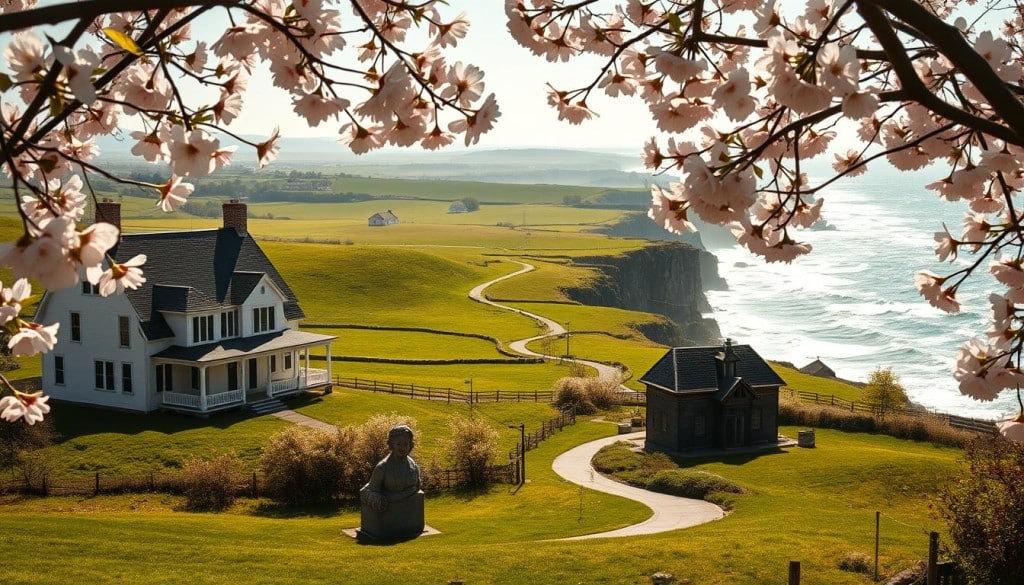The small yet impactful Prince Edward Island played a key role in the birth of a nation. It’s well-known for its beautiful scenery, but it also had doubts about joining Canada. This part of Canadian history is not widely known. Yet, it’s crucial for understanding Canada’s journey to unity. By exploring Prince Edward Island Confederation history , we see the early days of Canada. We also understand how this island contributed to the country’s foundation, despite its initial hesitations.
In 1864, Prince Edward Island hosted the Charlottetown Conference. This event was pivotal in shaping Canada. Through this Prince Edward Island history timeline , we see a story of tough choices and growing national pride. It tells how PEI went from financial trouble to being vital to Canada in 1873.
If you love Canada, history, or just want to learn, Prince Edward Island’s story is fascinating. We encourage you to explore with us. Let’s discover the famous red shores, beautiful scenes, and the historic events here. These events helped shape both Prince Edward Island and the whole country.
An Overview of Prince Edward Island’s Significance
Discover Prince Edward Island’s rich cultural heritage. Explore Charlottetown’s history that makes Canada’s smallest province stand out. Known as the “Garden of the Gulf,” it has a rich history and culture.
Geographic and Cultural Context
Prince Edward Island, in the Gulf of Saint Lawrence, is famous for its stunning landscapes and seafood. It has a strong cultural heritage. This comes from the Indigenous Mi’kmaq, French settlers, and British colonials. Each group has deeply influenced the island’s culture and history.
A Brief History Timeline
Let’s look at key events that have shaped Prince Edward Island:
- Pre-1700s – The Indigenous Mi’kmaq people create a rich culture and bond with the land.
- 1769 – St. John’s Island, now Prince Edward Island, becomes its own colony, separate from Nova Scotia.
- 1864 – Charlottetown Conference happens here. It’s a key event in creating the Canadian Confederation.
- 1873 – Prince Edward Island joins the Canadian Confederation. Railways and debt relief are big reasons.
Looking into Prince Edward Island’s history helps us understand today better. It prepares us for the future. The cultural heritage and Charlottetown’s history show the people’s resilience. They highlight a strong sense of community and national pride.
Indigenous Peoples of Prince Edward Island
We honor the rich Indigenous history of Prince Edward Island, a story stretching back thousands of years. The Mi’kmaq Nation first called this land Epekwitk, which means “cradled on the waves.” This beautiful name reflects the island’s setting, surrounded by the Atlantic Ocean.
The Mi’kmaq’s deep bond with the island and its waters is key to their rich cultural legacy. Mi’kmaq traditions remain vital today, shaping the cultural landscape of Prince Edward Island.
The Mi’kmaq Nation’s Heritage
The Mi’kmaq have preserved their identity through time, overcoming many challenges. Their resilience is seen in the vibrant continuance of their culture today.
Cultural Traditions and Practices
Mi’kmaq cultural traditions, from unique quillwork to Pow Wows, show their enduring spirit. These traditions invite everyone to explore and celebrate Mi’kmaq culture together.
The Epekwitk Assembly of Councils on Water Street is a hub for celebrating Mi’kmaq culture. It showcases their art, history, and traditions, educating and enriching our community.
European Discovery and Exploration
When Europeans first saw Prince Edward Island, it began an important story. In 1534, Jacques Cartier’s trip made the island known to Europe. This started a time of exploration and eventually, people settling there.
The history of the island highlights two key times: Early European Contact and French Settlement of Acadia . These periods shaped the island’s culture and landscape. They also started Acadian history in Prince Edward Island.
Early European Contact
Jacques Cartier’s visit started the European connection with Prince Edward Island. This didn’t lead to settling right away. But, it prepared the way for future interest by Europeans. This time was about exploring and charting the land. It was vital for the French’s later claims.
French Settlement of Acadia
In 1604, the French began to settle in what they called Île Saint-Jean. They made it part of Acadia. This settling is key to understanding the Acadian history there. The French impact is still seen in place names and the active Acadian community today.
The Acadian presence in Prince Edward Island saw both growth and hardship. It tells a story of keeping culture alive and building strong communities. The early settlers’ efforts created the diverse cultural fabric we see in the island today.
This summary shows how Europe influenced Prince Edward Island during those times:
| Period | Impact on Prince Edward Island |
|---|---|
| 1534 – European Discovery | Marked by Jacques Cartier’s exploration, establishing initial European interest in the region. |
| 1604 – French Settlement | Establishment of French presence through settlements, significantly shaping local culture and demographics. |
From early contacts to French settlement, Acadian history in Prince Edward Island tells a story of survival and cultural wealth. By celebrating and keeping this heritage alive, it remains a key part of the island’s identity today.
British Control and Colonization
After the Treaty of Utrecht in 1713, Prince Edward Island came under British rule. This event was a major turning point in its history. The island, first called St. John’s Island, underwent significant changes.
The era introduced complex land ownership issues due to absentee landlords. This situation held back local growth and farming potential. During this time, the roots of the Prince Edward Island pioneers were planted, changing the island’s population makeup.
“Prince Edward Island pioneers settled at a time when the land itself was embroiled in ownership conflicts, yet their resilience and ingenuity became the cornerstone of today’s vibrant community.”
Loyalists escaping the American Revolutionary War’s chaos also arrived. They brought new agricultural methods and community models. These changes were key for the island’s advancement.

| Period | Impact |
|---|---|
| Post Treaty of Utrecht | Shift from French to British control; introduction of absentee landlord system. |
| Loyalist Arrival | Introduction of diverse agricultural techniques and strengthening of the local economy through new settlements. |
The impact of the Prince Edward Island pioneers is still seen today. We find a community that honors its past while flourishing in the present. Their efforts have built a strong, culturally rich, and forward-looking Prince Edward Island.
A Journey to Confederation
Prince Edward Island played a key role in Canada’s history. The journey to Confederation is fascinating and complex. It was defined by important events and influential people that changed the Island’s political scene, leading to its joining with Canada.
At first, Prince Edward Island watched Confederation from a distance. Its strong economy and independence made joining less attractive. But, financial struggles soon changed their mind.
Key Players in the Confederation Movement
- Thomas Heath Haviland – a strong supporter of Confederation, Haviland’s diplomacy and vision were key in promoting the idea.
- Edward Whelan – known for his convincing journalism, Whelan showed the economic and security advantages of joining Confederation, influencing the public.
The Charlottetown Conference
The Charlottetown Conference of 1864 was a critical moment. It’s where Confederation’s foundations were discussed and formed. Prince Edward Island welcomed delegates from Nova Scotia, New Brunswick, and the Province of Canada. This made it a central spot in Canadian history.
In the beginning, resistance was strong. By the late 1860s, economic decline helped change views. Seeing a chance for economic support and stability with the larger Confederation, Prince Edward Island negotiated its terms. It joined Canada on July 1, 1873. This move boosted Prince Edward Island’s significance in Canadian history.
The Role of Agriculture in Island Life
Agriculture has been crucial to Prince Edward Island, shaping both its economy and culture. It started small and grew to lead in potato farming. The evolution of farming has been a key part of Prince Edward Island’s economic development history.
Farming Evolution Over the Centuries
Farming on the Island began with family plots. It then grew into a huge agri-business. At first, it was about farming for the family.
Then, advances like crop rotation and new tech improved farming. These changes made Prince Edward Island vital in Canada’s agriculture. Especially, its potato farming now makes up 25% of Canada’s total.
Impact on the Economy
Agriculture has hugely impacted Prince Edward Island’s economy. It has boosted the potato sector and other farming areas.
Farming here has kept up with world trends and cared for the environment. This has kept its lands and people thriving. Agriculture is essential to life on the Island. It feeds its people and drives the economy.
The Tourism Boom: Landscape and Culture
Prince Edward Island’s story of tourism is full of stunning landscapes and exciting cultural activities. Its beautiful scenes and fun events explain why so many visit this lovely island.
Prince Edward Island’s tourism history isn’t just about its amazing sights; it’s also about the island’s rich culture. The beautiful hills and sandy shores provide the perfect setting for many festivals. These events capture the hearts of both visitors and locals.
The blend of nature and culture makes the island a top travel spot. Let’s look at some features and happenings that boost tourism:
- Sweeping coastal views for peaceful breaks and beautiful photo ops.
- Lush landscapes and tours of historic lighthouses that share the area’s maritime history.
- Festivals that show off the island’s traditions and the strong sense of community.
| Event | Location | Description |
|---|---|---|
| Cavendish Beach Music Festival | Cavendish | A multi-day outdoor music festival featuring international country music stars and showcasing local talents. |
| PEI Shellfish Festival | Charlottetown | An annual festival celebrating Prince Edward Island’s renowned shellfish industry, attracting chefs and foodies from around the globe. |
| Fall Flavours Festival | Multiple venues across PEI | A month-long celebration of the island’s seasonal produce, featuring events hosted by celebrity chefs and local culinary experts. |
These features play a big role in Prince Edward Island’s tourism history . They showcase its beauty and vibrant local life, enticing visitors annually.
Prince Edward Island’s Literary Legacy
Exploring Prince Edward Island’s cultural heritage , its books and stories are key. They connect deeply with the area’s life and views. The beautiful nature and lively culture here inspire many writers and readers.
Home of Famous Authors
This island has produced beloved Canadian authors. They find inspiration in the green landscapes and historic sites. Lucy Maud Montgomery, especially with her Anne of Green Gables series, captures the island’s magic. She invites readers into its charming world through her lively tales.

Prince Edward Island’s writers do more than just create stories. They build a unique cultural identity. This identity enhances the arts and tourism. It highlights Prince Edward Island as a place of stories, not just a spot on the map.
Here’s a table showing key writers from Prince Edward Island. It shows how they help celebrate and share the island’s culture:
| Author | Notable Works | Impact on Culture |
|---|---|---|
| Lucy Maud Montgomery | Anne of Green Gables, Emily of New Moon | Promoted PEI’s landscapes and culture globally, heightened local tourism |
| Milton Acorn | The Island Means Minago | Illustrated PEI’s social and political landscapes, sinking deep into the socio-cultural roots of the island |
The books and poetry from this island capture its scenic and cultural spirit. They ensure Prince Edward Island’s cultural heritage continues to be celebrated by future generations.
The Impact of World Wars on Prince Edward Island
Prince Edward Island showed its strength and dedication during the World Wars. The island sent soldiers to fight and supported them from home. These times changed the island’s politics and affected its economy and society deeply.
- Local people volunteered to fight abroad, showing their courage and love for their country.
- The community came together to raise funds, ration supplies, and provide needed services.
- They used their local resources, like fish and farm products, to help in the war.
Post-War Changes
- The return of veterans sparked big changes in jobs and everyday life.
- There was a boost in government help for health and welfare after the war.
- The island’s politics slowly changed, leading to better local leadership and policies.
The World Wars left a lasting mark on Prince Edward Island, touching every part of life. These events shaped its role in Canada and built a strong, united community. This spirit of togetherness and toughness is still alive today.
Modern Governance: Provincial Developments
Prince Edward Island has a rich story of political growth, showing dedication to both new governance and historic roots. It went from a crucial part in forming Canada to navigating political changes over centuries. Now, its governance system tackles today’s challenges while respecting its history.
Political Structure and Responsibilities
Prince Edward Island has a parliamentary system with roots in its history. The province looks after healthcare, education, and infrastructure. Local governments focus on community issues. This ensures issues are addressed efficiently and accurately.
Recent Legislative Initiatives
The province’s latest laws focus on sustainability, economic growth, and better social welfare. Prince Edward Island is taking steps to ensure it meets the changing needs of its people.
- Implementation of advanced healthcare systems
- Reforms in education to include digital literacy
- Initiatives aimed at boosting local businesses
These steps not only meet current needs but also aim for future success and well-being.
We encourage you to take part in shaping our province’s political scene. By working together, we’re not just remembering Prince Edward Island’s history; we’re creating its future.
Celebrating Cultural Diversity Today
Prince Edward Island shines with its vibrant cultural mix, deeply rooted in its heritage. Events highlight the voices and traditions of various ethnic groups. This makes the island a lively place.
Recently, multicultural communities have grown, making the island a place of cultural sharing. Festivals allow traditional and modern cultures to blend and enrich each other.
In Prince Edward Island, every festival shows how welcoming and diverse the island is. These events aren’t just fun; they’re a proud display of the island’s cultural mix.
Events range from food festivals showing off international and local dishes to arts festivals with global music, dance, and art. These gatherings help different cultures connect, increasing understanding and respect.
- The Island Fringe Festival brings artists to perform in unique spots.
- The DiverseCity Multicultural Festival takes place in many cities, welcoming everyone.
- The PEI Shellfish Festival is popular, showcasing local seafood and dishes from other countries.
These celebrations help the local economy and make communities proud, strengthening Prince Edward Island’s unique culture.
Supporting these events helps keep our rich culture alive and promises a future of diversity and unity on Prince Edward Island. It’s a way to celebrate what makes our community unique and together.
The Future of Prince Edward Island
The future of Prince Edward Island looks bright and full of potential. We honor our history while moving forward. Our island is at an exciting point, balancing tradition with the promise of sustainable growth. We aim to protect our environment and encourage new ideas. This approach helps us respect our past and prepare for a strong future.
Current Challenges and Opportunities
Our path has challenges, but also great opportunities. We aim to grow our economy without harming our environment. This goal guides us with seriousness and hope. We turn our challenges into chances for innovation and making our community stronger. By focusing on renewable energy and eco-friendly tourism, we find ways to live well without hurting our island.
Visions for Sustainable Growth
We envision sustainable growth that mirrors our community’s values and pride. Our plans look far ahead, aiming to keep PEI vibrant for many years. We work with local businesses and encourage innovation. Supporting sectors that improve our lives is our goal. We want to create a bright future that shows the strong spirit of Canadians and the beauty of our island.






